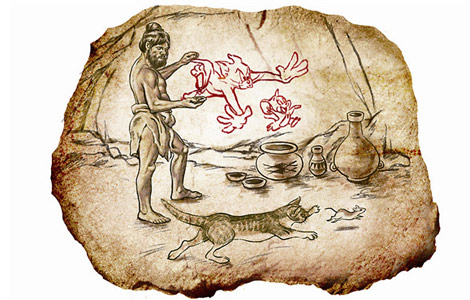Fine art goes underground
Updated: 2014-01-31 06:44
By Cecily Liu and Qiu Bo (China Daily Europe)
|
|||||||||||
Chen, who was born and bred in Changsha, Hunan province, started learning traditional Chinese painting when he was 7.
Painting has been a hobby of his over the years no matter how busy he has been with study and work, he says. Years of dedicated practice have made him a notable artist.
"I think painting is in my blood. I fell in love with it when I was small. I loved looking at the only books I could understand before I learnt how to read, and they were drawing books."
His first major breakthrough in Chinese art took place when as a teenager he sold a landscape painting to a Singapore businessman and art collector, he says.

"The outline was very simple, but it created a beautiful scene," Chen says. The man saw Chen's work at an exhibition and contacted him through a mutual friend.
"It was a lot of money for me at the time, and I used it to buy an expensive watch for my father. I still remember it."
In 1999, Chen moved to London to study creative technology at the London College of Music and Media. While there, he also worked part time in the media industry, editing videos and working on documentaries.
In 2008, he started his own business in Britain, which focused on organizing events to connect Chinese and British businesspeople. He also played a part in the setting up of the UK Chinese Business Association in 2012.
Chen says that traditional Chinese painting taught him important lessons about doing business, especially the need to judge a situation holistically and take action according to the bigger picture.
"In drawing, we have to care about details only as long as the bigger picture is satisfied. For example, there is no point in drawing a hair on a horse extremely well if the horse itself is not drawn well. Similarly, doing business requires finding the right balance."
But Chen says sometimes the two jobs demand completely different skills, because an artist is supposed to draw what he believes is right, whereas a businessman works mainly to serve his customers' needs. Understanding both ends of the spectrum is the key to doing both jobs well, he says.
As testimony to Chen's artistic achievement, the Bank of China's London branch hosted an exhibition of his work on the horse painting in September.
Chen says some of the 40 works at the exhibition sold, and he received many more orders for his horse paintings after the show. He says his paintings sell for about 6,000 ($9,950; 7,280 euros) to 20,000 pounds each.
Chen says many celebrities around the world, including some British politicians, are now collecting his work.
"Although my paintings originate from Chinese culture, at their core is a spiritual pursuit and longing, which I believe a Western audience can also appreciate," Chen says. "I think this is why my works are popular in the West."
Horses are a common feature in his work, because he has developed a special admiration for the animal.
He says the unique point about drawing a horse in a Chinese painting is the fast pace of the work, as one brush stroke can constitute an entire body part such as a leg or muscle.
"This is particularly challenging because I can't make any mistakes during the stroke. I must make it in a continuous flow at the right speed."
As Chinese ink painting is done on a thin piece of paper, the ink can easily make a thicker line than intended if the brush is left on a part of the paper for too long.
Chen says getting the speed right requires a lot of practice. Horses' legs are particularly difficult to draw because the painting is a still depiction that is supposed to capture a moving animal, he says.
Chen says traditional Chinese painting is not as fast a process as it seems because a lot of practice is required before the final painting is done.
"Even though a horse can be drawn in 30 minutes, it takes years of practice to learn how to make those brush strokes."
Those years of practice enabled Chen to complete the Chinese New Year celebration poster in one week, which included three days of painting. Each day, he painted for about three hours in the morning when his concentration was at its best.
In future, Chen says, he hopes to combine his work as a businessman and his hobby as an artist more often.
He is now in the process of establishing Chen Qian Art Space, a platform that takes the best of Western art to exhibit and sell in China and vice versa.
"The art space is not a permanent exhibition venue, but a dedicated team that goes out to look for leading art works, and we will arrange for these pieces to be exhibited at suitable venues."
Contact the writers through cecilyliu@chinadaily.com.cn
( China Daily European Weekly 01/31/2014 page28)
Today's Top News
Joint operation ensnares poachers
China's largest private charity elects new chiefs
Action needed to halt bird flu, experts warn
French president coming alone to White House
Geneva II talks resume over Syria
UN agency says Iran probe needs more work
Giraffe shot and dismembered in Copenhagen Zoo
Minimum alcohol price would save UK lives
Hot Topics
Lunar probe , China growth forecasts, Emission rules get tougher, China seen through 'colored lens', International board,
Editor's Picks

|

|

|

|

|

|





